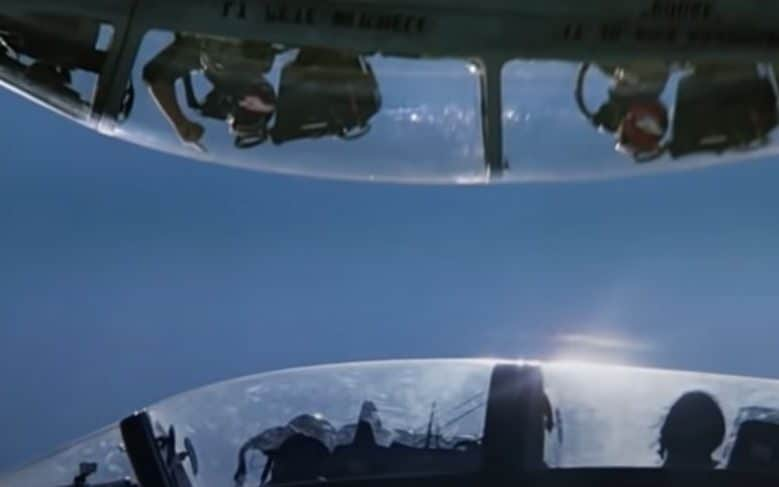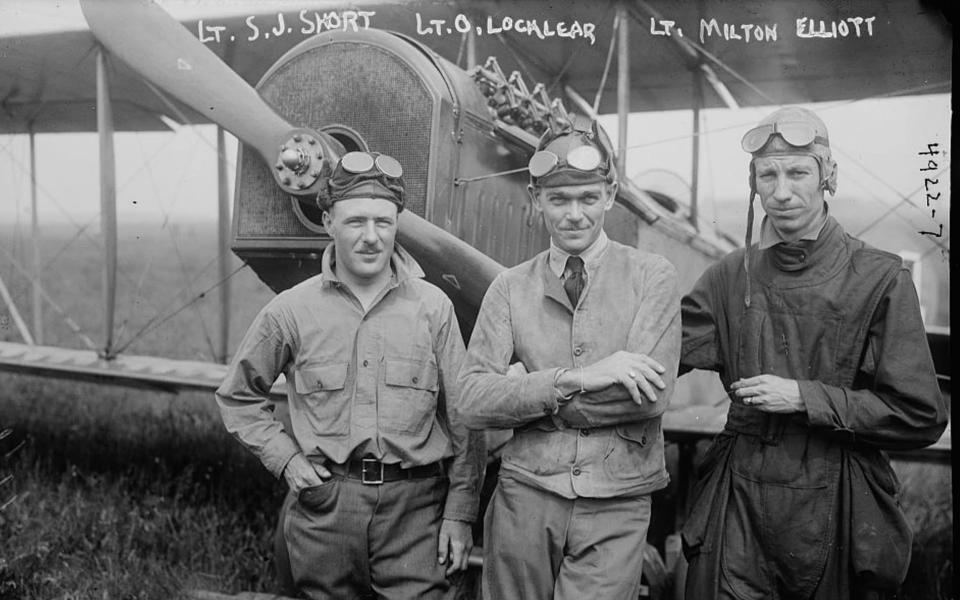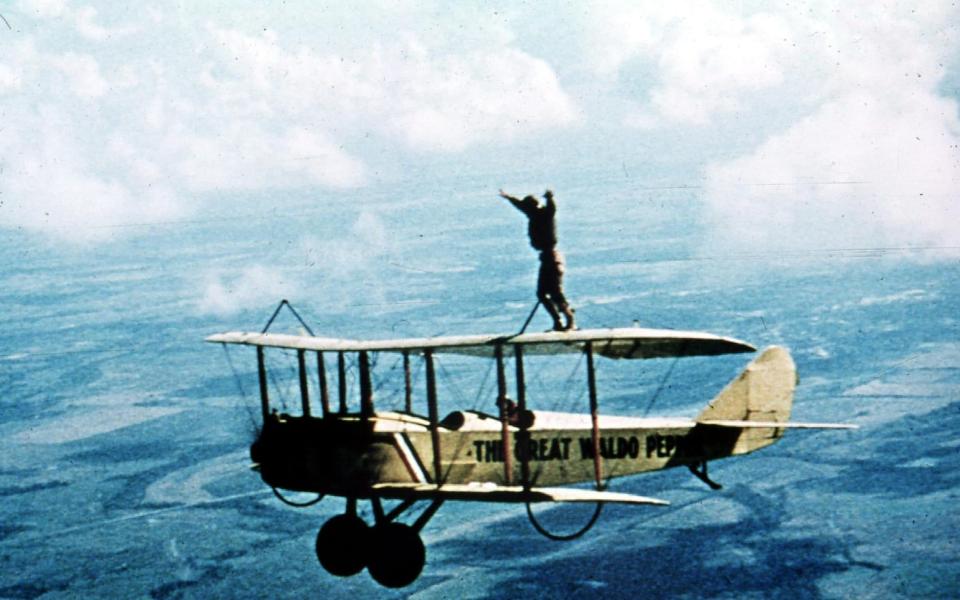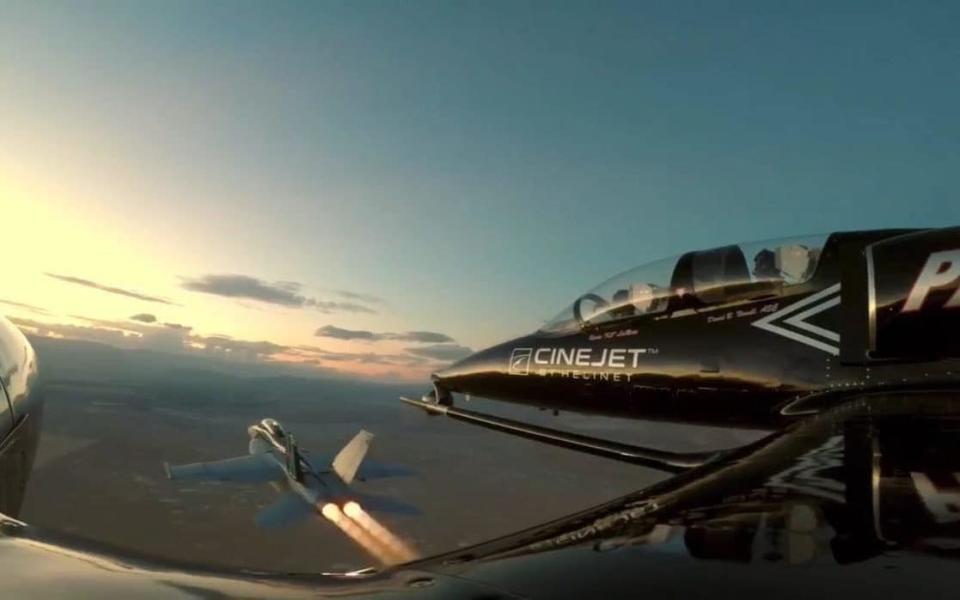The Top Gun stunt pilots risking their lives for Tom Cruise

On September 16, 1985, Art Scholl – famed aerobatic stunt pilot and aerial cameraman – took to the skies for Top Gun. Flying several miles off the coast of Carlsbad, California in his Pitts Special biplane, Scholl’s job was to capture “plates” – background footage that could be superimposed onto bluescreen behind the actors. That is, the actors who, unlike Tom Cruise as ace pilot “Maverick”, couldn’t hack it in a real fighter jet.
A celebrity from American airshows, Scholl was a legend among pilots, including the real-life Navy pilots who flew for Top Gun. Scholl was also well renowned in the film industry as the go-to man for capturing aerial footage. His film credits included The Right Stuff and Iron Eagle.
For Scholl, stunt flying was not about guts but discipline – the ability to “make an aeroplane do exactly what you want it to do every time.”
The Top Gun gig was relatively mundane: performing an inverted flat spin – putting the plane upside down and spinning like a top – for dizzying footage of land and sea, land and sea, round and round. But something went wrong – possibly a mechanical error. At 35,000ft, Scholl radioed to say “I’ve got a problem” and then – at 25,000ft – “I’ve got a big problem”.
Another plane had been following behind, but Scholl asked them to stay back and keep out of shot. The other pilots watched Scholl go through clouds. By the time they’d come through the clouds themselves, he was gone. Scholl crashed into the Pacific Ocean. His body and plane were never recovered.

Dave Baranek is a former instructor from the real-life Fighter Weapons School, nicknamed Topgun (on which the film was based). Baranek both flew and consulted on the movie. On the day Scholl died, he had travelled to Paramount to consult on dialogue. He was standing next to director Tony Scott when the call came through. Stunned by the news, Tony Scott immediately went off to call Scholl’s wife, Judy.
“I just sat there, shocked,” says Baranek. “I never met Art Scholl but he was an airshow legend. He got killed doing this rather mundane filming job. What he was doing was not particularly dangerous. He did it all the time. It just happened that something went wrong on that last flight. And that was it. It was done.”
Reporting on the accident, the Los Angeles Times described Scholl as “the last of three top Hollywood stunt pilots”, along with Paul Mantz and Frank Tallman, who both died in the cockpit years earlier.
Thirty-seven years on – with Top Gun: Maverick about to soar into cinemas – stunt piloting is a small, niche business. “There’s not a lot of us,” says Kevin LaRosa II, aerial coordinator and camera pilot on Top Gun: Maverick. “Not just in the United States, but worldwide… There are maybe 10 film pilots in the United States, and four or five that work heavily on the large films. Worldwide, maybe 20.”
Safety is paramount. “There are inherent risks with any flying,” says LaRosa. “As a stunt pilot, or camera pilot, our job is to de-risk to the extent that we can still make an amazing shot – to make sure that we’re never risking lives. We practice excellence in repetition. If there is doubt that something could go wrong, we figure out a better way to do it.”
Stunt flying came from the “barnstormers” of the early 20th Century – daring pilots who travelled the US, landing from town to town, usually on farmland, and dazzled locals with aerial tricks.
The most famous of the early stunt pilots was Ormer Locklear, a Clark Gable look-alike who was one of the great wing-walkers (as in, walking on the wings of a plane while hundreds of feet in the air) and the first man to transfer between two planes mid-flight. Other tricks included dangling by his legs from the landing gear, and doing headstands just behind the propeller.
Flying to Hollywood, Locklear became cinema’s first superstar stunt pilot. He starred in 1919’s The Great Air Robbery, performing the first car-to-plane transfer on film. One year later, Locklear and a flying partner were killed making The Skywayman. Filming a daring night-time descent, Locklear – who was possibly blinded by the film’s lights – crashed in a ball of flames.
In 1924, a gang of stuntmen created the “13 Black Cats”, a rudimentary union. As detailed by stunt flying historians Jim and Maxine Greenwood, fees for air stunts included $50 for a spinning plane (fire included); $100 for flying upside down or a mid-air transfer; $150 for jumping from a plane and freefalling 1,000ft before pulling the ripcord; $1,200 for crashing; or $1,500 for blowing up the plane in mid-flight and parachuting out. Most of the Cats died in various acts of daredevilry. Herd McClellan, a specialist in delayed parachute jumps, invented a bulletproof vest and demonstrated it at public shows. The vest wore thin from overuse until a bullet passed right through and killed him.

The 1927 silent film Wings – winner of the first ever Best Picture Academy Award – used real military pilots (pre-empting Top Gun by almost 60 years). Civilian pilots were not permitted to fly the military aircraft used in the film, so a number of service pilots were assigned to actors and crouched behind them in the planes, to give the impression that the actors were flying.
Among the stunt pilots on Wings was Dick Grace, a crash specialist; he performed four for the film. On the fourth crash, his head hit the instrument panel and broke his neck – one of 80-plus bones that Grace broke over the years. Surviving the neck-break, Grace was one of the few early stunt pilots who didn’t die in the cockpit. In those early days, death seemed like an inevitable hazard of the job.
Wings’ success inspired a number of aviation flicks, including Howard Hughes’ 1930 epic, Hell’s Angels. Three pilots and a mechanic were killed making the film. The chief pilot was a stuntman named Frank Clarke, who performed a 10,000ft dive in a Fokker D-VII. Howards Hughes himself crashed during the making of the film, while – during a hot-headed moment – he attempted to show his pilots how to fly closer to camera positions.
In 1931, a group of fliers formed the Associated Motion Picture Pilots (AMPP), the first official union. Among their number was Frank Clarke, Dick Grace, and Florence “Pancho” Barnes, a California socialite and Hollywood’s first female stunt pilot.
The most famous stunt pilot of all was Paul Mantz, who Jim and Maxine Greenwood described as the “dean of movie fliers”. In his first major film, the 1932 adventure Air Mail, Mantz flew a plane through a 45-foot-wide aircraft hangar (flying through buildings became his forte). Despite being a flight school washout, Mantz was commissioned to serve in the First Motion Picture Unit during WWII, producing propaganda and training films. After the war he returned to Hollywood.

Other notable stunts included Mantz landing a plane on its belly, without wheels, for the 1949 Gregory Peck actioner Twelve O’Clock High, and flying a biplane between two trees and shearing off the wings, as seen in the 1950 comedy When Willie Comes Marching Home. Later, Mantz formed a partnership with fellow flier Frank Tallman and together, they cornered the Hollywood flying market.
Tallman flew on the 1963 comedy It’s a Mad, Mad, Mad, Mad World, doing a variety of stunts. Most famously, he flew through a Coca-Cola billboard ad. Crashing through at 160mph, the plane’s wingspan had less than three feet of clearance on each side.
By that time, Mantz worked largely behind the camera, directing shots from a B-52 camera plane. But Mantz flew a specially-built hybrid plane for 1965’s The Flight of the Phoenix. Frank Tallman had been scheduled to fly for the scenes, but Mantz took over when Tallman fell at home and shattered his kneecap.

The scenes were filmed and in the can, but Mantz was asked to fly again for backup shots. As he flew just above Californian sand dunes, the plane's right gear clipped the sun-baked ground, causing Mantz to lose control. The fuselage snapped and the plane cartwheeled, killing Mantz. “For over three decades movie producers had been congratulating Mantz for his sensational flying scenes and then asking for just one more,” wrote Jim and Maxine Greenwood.
Tallman, meanwhile, had his leg amputated above the knee but later taught himself to fly with a prosthetic leg. In subsequent years he worked on such films as Catch 22, The Great Waldo Pepper, and Capricorn One.
In 1985, Top Gun was made with the cooperation of the US Navy and used real fighter aircraft, including the film’s star plane, the F-14 Tomcat. They were flown by real Topgun instructors and naval aviators.
Dave Baranek – call sign “Bio” – was a RIO (Radio Intercept Officer). Like Maverick’s best pal, Goose (Anthony Edwards), it was Baranek’s job to sit in the rear cockpit and oversee – among other things – navigation and communication. He became a Topgun instructor in August 1984. Baranek details his career and work on Top Gun in the book, Topgun Days.
Baranek was among 16 instructors who flew in the film, but jokes about the term “stunt pilot”. “That’s the last thing that a Topgun instructor would want to be called or want to teach!” he laughs. “We taught combat tactics.”
In the film, Baranek flew in the rear cockpit of a Northrop F-5F, disguised as the villainous (and fictional) MiG-28. It’s Baranek who gets the middle finger from Tom Cruise’s Maverick, when Maverick and Goose fly inverted over the enemy plane. At least, it might be Baranek. The scene was shot several times with a number of airmen (“I say it’s me, I think it’s me, but I cannot prove it’s me!”).
The inverted plane is one of the few flying tricks created in post-production. Flying inverted so close to another plane was too risky. But as director Tony Scott said, “99.9 per cent” of the flying footage was real in Top Gun. The action was captured by a camera-mounted Learjet, piloted by legendary air racer Clay Lacy, and an F-14 kitted out with multiple cameras – dubbed “the camera bird”.
The action required manoeuvres that wouldn't happen in real training or combat, such as an aileron roll – a flashy, 360 spin that looks good but makes no tactical sense. “Some things looked good on film but they would not be allowed in training, or would be unlikely in a real combat situation,” says Baranek.
One example is how close the F-14s fly next to each other in formation. “In training, we stayed 500ft away from other aeroplanes for safety,” says Baranek. “But in the movie, if they stayed 500ft apart they look like specs on screen. We acknowledged that it was not a dynamic training environment – it was a carefully scripted filming environment – so, we flew in much closer than 500ft.”

Baranek flew during scenes of the MiG28s menacing the US pilots. “They had the F-14s fly behind the Learjet and the so-called MiG28s, actually Topgun F-5s, flying below and behind the F-14s,” Baranek says. “We had to stay close together, so it looked good on camera, and avoid hitting each other. We had small distance and small altitude separation, while we were weaving back and forth and menacing the F-14s. Another scene I was involved in was the head-on passes. We started out with our normal 500ft separation and got closer and closer. It was exciting to see these F-14s flashing by so close.”
The style of flying created its own dangers. “It was very different to dynamic free play of air combat training,” says Baranek. “We had to shift into a different mindset. But it’s just as dangerous. When you fly in that close, doing head-on passes, inside of 500ft, and you’re going 300 knots or more, so the closure is 600 knots, it takes a lot of control, skill, and discipline.”
For Top Gun: Maverick, technological advancements have changed the aerial game: both in fighter planes used – the F/A-18 Hornets and Super Hornets and fifth generation Su-57s – and how the action is filmed, using the highly-sophisticated Cinejet, a camera plane developed by aerial coordinator Kevin LaRosa II.
Though some aviators balk at the “stunt pilot” moniker (even Paul Mantz preferred the term “precision pilot”), LaRosa wears it proudly. He’s a second-generation stunt pilot. His father, Kevin LaRosa, has a movie CV dating back to the early Eighties. He was one of the pilots on the TV show Airwolf. “I used to fly in Airwolf as a baby!” says LaRosa II, and points to a scene in the 2001 Robert Redford film The Last Castle as one of his father’s greatest moments: “He flew a military Huey inside of a prison – an extremely confined area with this big helicopter. You can’t really tell in the movie, but they were shooting him with water cannons, he’s got a guy dangling below his skid, and he’s ripping around in this courtyard with a massive helicopter – with precision to the inch every time.”
In Top Gun: Maverick, the on-screen flying was once again done by Navy pilots – and Tom Cruise himself, of course, who flew his own WWII-era P-51 Mustang. “I always say there are pilots and there are aviators,” says Kevin LaRosa. “Tom Cruise is an aviator in the truest sense. He flies beautifully and with precision.”

As the film's aerial coordinator, LaRosa was responsible for all aircraft, both military and civilian. As lead camera pilot, it was LaRosa’s job to keep up with the fighters – to put the aerial cinematographers in the right place to film the action. Essentially it's behind-the-scenes stunt piloting. “We’re dodging trees and rocks and chasing other aeroplanes,” he says. Indeed, some of Top Gun: Maverick’s most exciting aerial sequences happen close to the ground, jetting through canyons – something that creates its own set of variables and risks.
“We see the F-18 Super Hornets flying through these canyons at 500 knots, pulling seven and a half Gs,” says LaRosa. “What people don’t realise is that when the camera’s on the outside of the F-18, that means there’s another aeroplane in that canyon right next to it – typically me in the Cinejet with an aerial DP [cinematographer] behind me. So there are two jets next to each other, weaving through the canyons and getting that footage.”
One risk of flying so close to an F/A-18 is the wake – the turbulence behind the plane. “These F-18s weigh in excess of 40,000lbs,” LaRosa says. “The wake from these aircraft is intense – it’s huge – it would roll my aircraft and put us in the ground. Not only am I avoiding the aircraft itself, I’m avoiding this wake that you can’t see.”
The key to creating these scenes is what LaRosa calls “excellence through repetition”. They map and fly through the action carefully, with a “crawl, walk, run mentality”. “When the Navy pilots and I go through that canyon,” says LaRosa, “we know where every tree is, where every gust of wind comes off every corner. We name them all, we colour code them all. By the time we’re in there filming, we know our moves and that canyon so well that it’s an extension of our body, and we’re concentrating on the shot composition.”
Some the manoeuvres might not be plausible in terms of realistic training (one of Maverick’s moves, shooting vertically between two F/A-18s during dogfighting training would, according to former Hornet pilot T.R.“Wombat” Matson, end in dismissal: “If you don’t hit the other two planes and everybody dies, when you land they’re going to rip your wings off your chest”) but the aerial action is absolutely real. “We never allowed ourselves to film a blank sky and have a CG aircraft built in,” says LaRosa. “Every time you see an asset in the air, there’s an aircraft there… That means the flight dynamic looks real, the reflections look real.”
In some cases, they “reskinned” planes – essentially a CG paint job. The opening scene features a futuristic-looking hypersonic plane, which Maverick attempts to fly to Mach 10 (ten times the speed of sound). It's actually an F/A-18 reskinned to look like the in-development Lockheed Martin SR-72. Elsewhere, fifth-generation fighters (the most advanced fighter planes available) perform manoeuvres that require thrust vectoring nozzles (which control the direction of the thrust for added manoeuvrability), but are digitally reskinned to look like F/A-18s.
One manoeuvre seen is a Pugachev Cobra, or something close to it. The plane suddenly rears up, raising its nose to stand vertically – the nose can even turn slightly backwards – before returning to a horizontal position. The move is only possible with thrust-vectoring. The F/A-18 can’t do a “true cobra”, says LaRosa, but it does its own version. “The F-18 has these amazing, giant surfaces – the elevators and ailerons and rudders. The jet is able to squat and decelerate very quickly, and point that nose in the air. The thing would light up with vapour. It’s an incredible thing to see live.”
Stunt piloting has flown a long way since the days of wing-walking. “The way I see stunt piloting now,” says LaRosa, “is we are experts at turning dreams into reality, storyboards into practical flying.”

